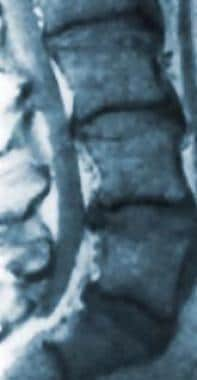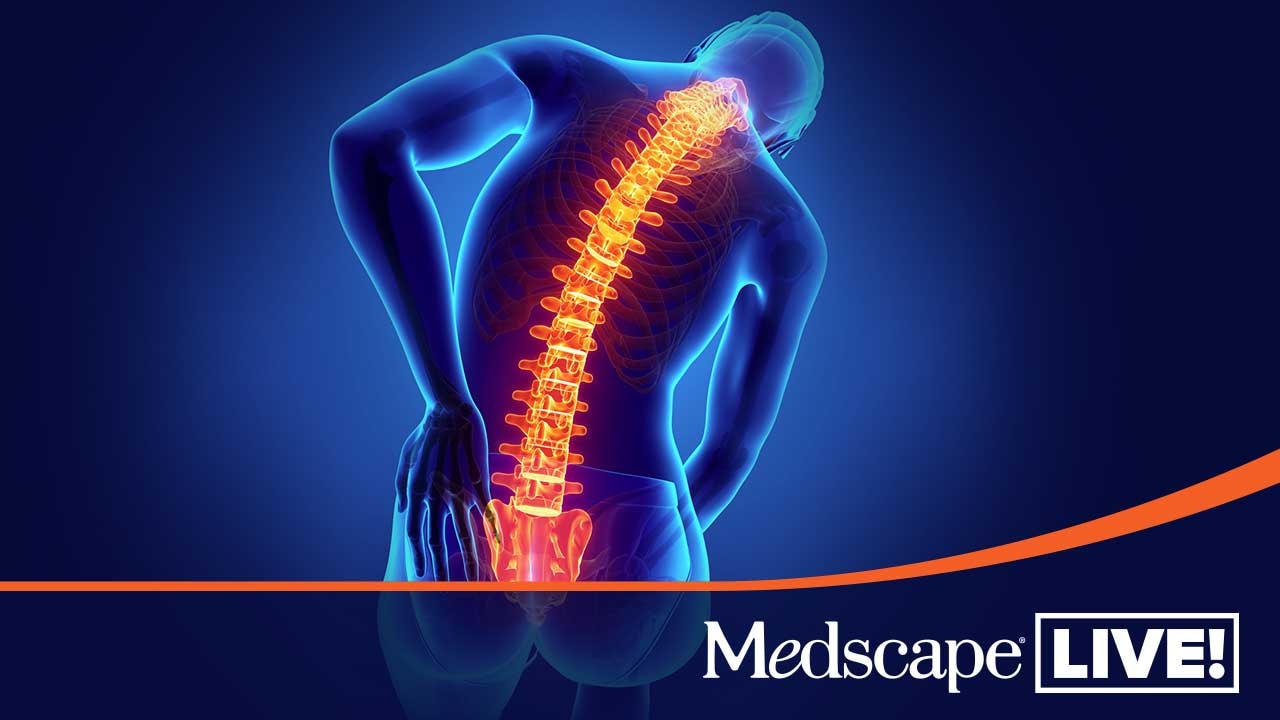Practice Essentials
Mechanical low back pain is one of the most common patient complaints expressed to emergency physicians in the United States accounting for more than 6 million cases annually. Approximately two thirds of adults are affected by mechanical low back pain at some point in their lives, making it the second most common complaint in ambulatory medicine and the third most expensive disorder in terms of health care dollars spent surpassed only by cancer and heart disease. [1, 2, 45]
The image below illustrates a herniated nucleus pulposus at multiple levels, one of the causes of low back pain.
 Magnetic resonance image of the lumbar spine. This image demonstrates a herniated nucleus pulposus at multiple levels.
Magnetic resonance image of the lumbar spine. This image demonstrates a herniated nucleus pulposus at multiple levels.
See Back Pain: Find the Cause, Watch for the Comeback, a Critical Images slideshow, to help diagnose and manage this common problem.
Low back pain reportedly occurs at least once in 85% of adults younger than 50 years, and 15-20% of Americans have at least one episode of back pain per year. Of these patients, only 20% can be given a precise pathoanatomic diagnosis. Low back pain affects men and women equally. The onset most frequently occurs in people aged 30-50 years. Low back pain is the most common and most expensive cause of work-related disability in the United States. [3, 2] Smokers appear to have an increased incidence of back pain compared with nonsmokers. Furthermore, the incidence of current smoking and the association with low back pain is higher in adolescents than in adults. [4]
The American College of Radiology (ACR) has published appropriateness criteria for low back pain, including the following [5] :
-
Uncomplicated acute low back pain and/or radiculopathy are benign, self-limited conditions that do not warrant any imaging studies.
-
MRI of the lumbar spine should be considered for those patients presenting with red flags [42] raising suspicion for a serious underlying condition, such as cauda equine syndrome, malignancy, or infection.
-
In patients with a history of low-velocity trauma, osteoporosis, or chronic steroid use, initial evaluation with radiographs is recommended.
-
In the absence of red flags, first-line treatment for chronic low back pain remains conservative therapy with both pharmacologic and nonpharmacologic (eg, exercise, remaining active) therapy.
-
If there are persistent or progressive symptoms during or following 6 weeks of conservative management and the patient is a surgery or intervention candidate or diagnostic uncertainty remains, MRI of the lumbar spine has become the initial imaging modality of choice in evaluating complicated low back pain.
-
MRI is the imaging procedure of choice in patients suspected of cord compression or spinal cord injury.
-
Patients with recurrent low back pain and history of prior surgical intervention should be evaluated with contrast-enhanced MRI.
Pathophysiology
Many causes of mechanical low back pain exist. The most common causes are age-related degenerative disc and facet processes and muscle- or ligament-related injuries. Discussion in this article is limited to musculoskeletal causes. These can be divided into nerve root syndromes, musculoskeletal pain syndromes, and skeletal causes.
Nerve root syndromes
Classic nerve root syndrome is characterized by radicular pain arising from nerve root impingement due to herniated discs. A similar syndrome can also be produced by inflammation and irritation, which may explain why patients whose presentation is consistent with this diagnosis respond to conservative therapies.
Impingement pain tends to be sharp, well localized, and can be associated with paresthesia, whereas irritation pain tends to be dull, poorly localized, and without paresthesia. Impingement is associated with a positive straight leg raising sign (ie, shooting pain down ipsilateral leg with leg raising), while irritation is not. Neurologic deficits and pain radiation below the knee are rarely seen in irritation alone and are most commonly found with impingement. [6]
The cause of impingement syndrome is most commonly herniated discs, but it may also be caused by spinal stenosis, spinal degeneration, or cauda equina syndrome.
Herniated discs are produced as spinal discs degenerate. After growing thinner, the nucleus pulposus herniates out of the central cavity against a nerve root. Intervertebral discs begin to degenerate by the third decade of life, and herniated discs are found on autopsy in one third of adults older than 20 years. Only 3% of these, however, are symptomatic. [7] The most common locations for herniation are L4, L5, and S1. [8]
Spinal stenosis occurs when disc spaces decrease as intervertebral discs lose moisture and volume with age. Even minor trauma under these circumstances can cause inflammation or nerve root impingement, which can produce classic sciatica pain without disc rupture. The pain can often be bilateral. [9]
Spinal degeneration is caused by alterations in the hygroscopic quality of the nucleus pulposus. This process progresses to annular degeneration. Coupled with progressive posterior facet disease, this process leads to spinal canal or foraminal encroachment. These retrogressive and proliferative changes in the disc anteriorly and the joints posteriorly produce clinical symptoms and radiographic findings termed 3-joint complex degeneration. Spinal degeneration has 3 distinct stages, as follows:
-
Dysfunction with complaints of pain only
-
Instability with advanced degeneration, pseudospondylolisthesis, and neurologic abnormalities
-
Stabilization with morning stiffness and with prolonged standing or walking, producing radicular pain
Cauda equina syndrome is produced by massive midline extrusion of nuclear material or tumor into the spinal canal, which compresses the caudal sac. The classic presentation is bilateral sciatica, with lower extremity bowel or bladder dysfunction present in 90% of patients. Urinary retention is initially observed and followed by overflow incontinence. Perineal or perianal anesthesia is present in 60-80% of patients. [10]
Musculoskeletal pain syndromes
Musculoskeletal pain syndromes that produce low back pain include myofascial pain syndromes and fibromyalgia.
Myofascial pain is characterized by pain and tenderness over localized areas (trigger points), loss of range of motion in the involved muscle groups, and pain radiating in a characteristic distribution but restricted to a peripheral nerve. Relief of pain is often reported when the involved muscle group is stretched.
Fibromyalgia results in pain and tenderness on palpation of 11 of 18 trigger points, one of which is the low back area, as classified by the American College of Rheumatology. Generalized stiffness, fatigue, and muscle ache are reported.
Other skeletal causes
Other skeletal causes of low back pain include osteomyelitis, sacroiliitis, and malignancy.
Osteomyelitis results from infectious processes involving the bones of the spine, while sacroiliitis results from inflammatory changes in the sacroiliac joints. This pain presents over the sacroiliac joints and radiates to the anterior and posterior thighs. This pain is usually worse at night and is exacerbated by prolonged sitting or standing.
Malignant tumors of the spine can be primary or metastatic. Most primary spinal tumors are found in patients younger than 30 years and usually involve the posterior vertebral elements. Metastatic tumors are found mostly in patients older than 50 years and tend to occur in the anterior aspects of the vertebral body. [11] Metastatic disease is more common than primary tumors of the spine, and thoracic spine metastatic lesions are more common than lumbar. Caution is advised, in that these traditional "red flags" have sufficient evidence in detecting spinal malignancy if based on the presence of a single red flag. However, the presence of more than 2 of these together should increase suspicion for the need for further workup. [12]
Epidemiology
Mechanical low back pain is one of the most common patient complaints expressed to emergency physicians in the United States accounting for more than 6 million cases annually. Global studies have shown that low back pain is one of the most common complaints experienced by physicians in most countries. [13, 2]
According to the Nationwide Inpatient Sample (NIS), approximately 183,151 patients with a primary diagnosis of low back pain were discharged from US hospitals between 1998 and 2007. During this period, an average of 65% of these patients were admitted through the ER, with a significant increase from 1998 (54%) to 2005 (71%). Multivariate analysis showed that uninsured patients (OR 2.1, 95% CI 1.7-2.6, P< 0.0001) and African American patients (OR 1.5, 95% CI 1.2-1.7, P< 0.0001) were significantly more likely to be admitted through the ER than private insurance patients or Caucasian patients, respectively. [14]
Most etiologies of mechanical low back pain are not life threatening; however, significant morbidity is associated with chronic low back pain syndromes. A significant number of patients are unable to return to their normal daily routines or function in a productive work environment secondary to low back pain. [3] Most cases of back pain treated in the emergency department are not true emergencies, with the exception of cauda equina syndrome. Patients who have cauda equina syndrome must undergo surgical decompression as soon as possible or face permanent neurologic damage.
Low back pain is a common complaint in adults of all ages, and it is becoming an increasing complaint in children and adolescents. A study following children from age 14 years into adulthood suggests that obesity in childhood, particularly in females, is a risk factor for later hospitalization for sciatica. This study also reported an increased risk of hospitalization for sciatica in males who smoked at a young age. [15]
Prognosis
The prognosis is good for most patients who present with mechanical back pain. [16, 17] Overall, 70% of patients feel better in 1 week; 80%, in 2 weeks; and 90%, in 1 month. Only 10% of all patients with low back pain have long-term problems.
A significant functional overlay or component of secondary gain is present in a subgroup of patients, who also account for the majority of office visits with low back pain complaints (see Causes section).
Recurrence is common and seen in up to 40% of patients within 6 months. Prevention methods should be discussed with patients with low back pain along with encouragement to monitor them when the acute period has resolved.
Psychosocial factors such as presence of posttraumatic stress disorder, use of a lawyer, presence of other chronic illnesses, and lower education levels appear to be positive predictors of development of chronic back pain in patients who sustain an initial injury to their back. Chronic back pain development was not associated with age, gender, occupation, or severity of original injury. [43]
A systematic review by Chou and Shekelle found that the following factors were most helpful for predicting which patients would experience persistent disabling low back pain: maladaptive pain coping behaviors, nonorganic signs, functional impairment, general health status, and presence of psychiatric comorbidities. Factors related to the patient's work environment, baseline pain, and presence of radiculopathy are less useful for predicting worse outcomes. [18]
Patient Education
Patient education focuses on prevention and includes the following:
-
Promoting weight loss where indicated
-
Performing back strengthening exercises
-
Teaching proper lifting technique
-
Increasing overall physical conditioning
Back belts, which are commonly worn in occupations with heavy lifting, have not been proven to prevent back injury.
For patient education resources, see the Bone Health Center; Back, Ribs, Neck, and Head Center; and Muscle Disorders Center, as well as Back Pain, Chronic Pain, and Sciatica.
-
Magnetic resonance image of the lumbar spine. This image demonstrates a herniated nucleus pulposus at multiple levels.








